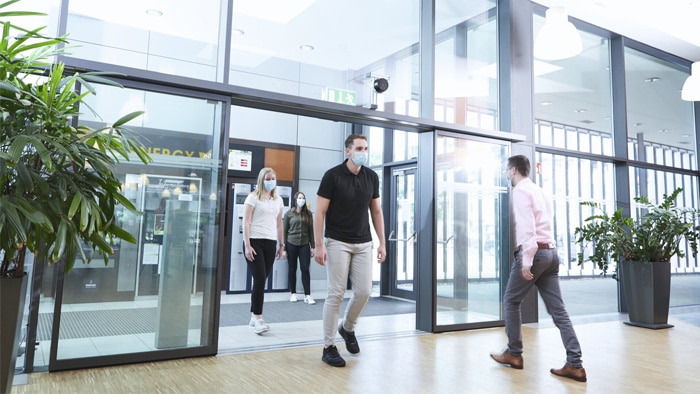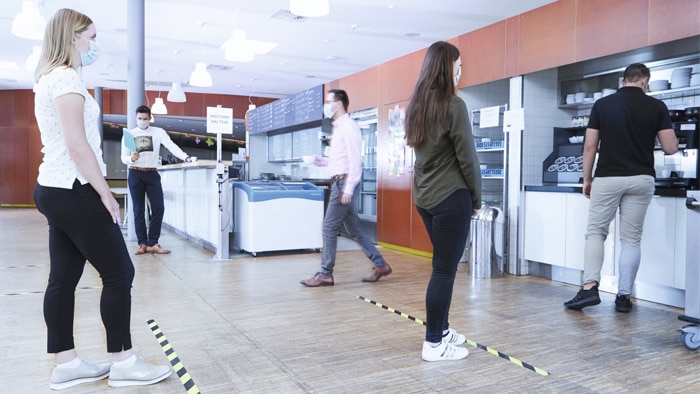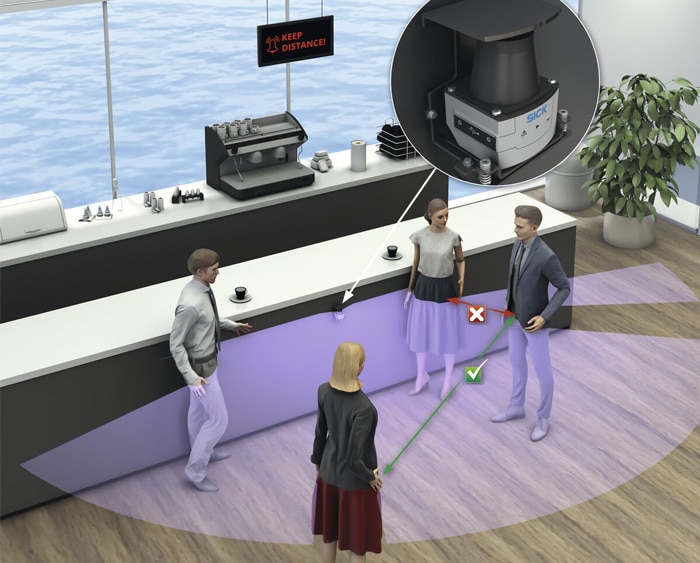Count people without making contact and reliably keep distance. This is the simple recipe for success of two new solutions that SICK is currently launching to help deal with the current situation. PeopleCounter and DistanceGuard are based on existing 3D and 2D LiDAR sensors and were developed through the SICK AppSpace ecosystem exclusively for the tasks named above. They are a very elegant and efficient way to react to the new requirements of these unusual times. SICK has once again proved the enormous importance of intelligent use of sensor technology, particularly in the civil and health care sectors. Protecting humans with technology – that is what counts here.
Counting people: measuring space utilization and distances
The sensor solutions do not record any personal information, and they allow companies to adhere not only to the requisite hygiene, but also data privacy requirements. Operating entities of institutions of public life as well as those that deal in tourism, gastronomy, retail and various other industries can profit from a simple solution for easily keeping the maximum utilization of space and the minimum distance between people in view.
PeopleCounter – counting people without making contact
PeopleCounter reliably differentiates between people and objects. It also works very well from a distance. The sensor identifies people using their contours with the help of the app. This means only the silhouettes of people are counted, while objects are blanked out – but personal information is never recorded.
This is technically very challenging: Based on the hardware of the MRS1000 3D LiDAR sensor, the application generates measurement data as a point cloud. Thanks to the four layers of the sensor, the direction of movement of a person is clearly established, monitoring the current utilization of a defined zone. The recorded data is output via telegrams and digital outputs to keep track of the maximum number of people. The applications range from small entry areas to large locations with a large number of visitors. The combination of several sensors makes it possible to cover even large areas with different entry and exit points, such as shopping centers, airports or trade fairs.
DistanceGuard – a restrained alarm system
Red and white spacing strips stuck to the ground are inventive but temporary solutions in many places. With DistanceGuard, SICK is saying goodbye to the temporary nature of this solution, but not to its praiseworthy ingenuity. The SICK solution boasts the advantage that the system naturally still works when distance rules change. In connection with a 2D LiDAR sensor, DistanceGuard SensorApp reliably measures the distance between two people. This can be very helpful at gatherings, in lines or in other dynamic crowds of people.
Depending on how great the distance should or may be in waiting areas, people are alerted when there is a violation. As soon as the distance between two people falls short of the configured minimum distance, a signal is generated. With the connection of a digital switching output, the customer has the choice between a light, sound or visual signal, for example. DistanceGuard also records the number of people in the selected measuring area and can send out a warning when the defined maximum number is exceeded. This makes it possible to avoid large crowds of people and better ensure square meter restrictions.
SICK AppSpace makes it possible
PeopleCounter and DistanceGuard are prime examples of what the SICK AppSpace can do. Programmable sensors can be configured quickly for new tasks using SensorApps. The new applications of the MRS1000P and TiM8xxP LiDAR sensors were also developed using the SICK AppSpace and can be configured for different environments using the finished app. The use of individualized and easy-configure 2D and 3D point clouds is a very practical application in this context.
Many other SensorApps are already available for download via the SICK AppPool. For specific applications, SensorApps can also be used independently by the customer or developed together with SICK experts with the support of a developer community. And as you can see here, everything we have said about the adaptability of applications also goes the other way. Because what we make possible for people also applies for your manufacturing processes – and we make these more efficient and competitive thanks to solutions using industrial data processing of point clouds to image files.
Read more:
3D LiDAR sensor detects the penguin even in its black tails
The platform screen doors on the Seoul Metro are monitored by 2D laser scanners
3D localization with the Belt Pick SensorApp for pick-and-place tasks
More layers open up more perspectives
Martin Klingele
测距业务部主管
Martin Klingele 自 2009 年起担任测距部主管,是其所在领域的绝对专家。他和他的团队一起负责用于测量、定位、记录、检查和质量管理的前瞻性解决方案。这位受过高等教育的电气工程师在 SICK 担任过应用工程师和产品经理,已在公司工作了 20 多年。





